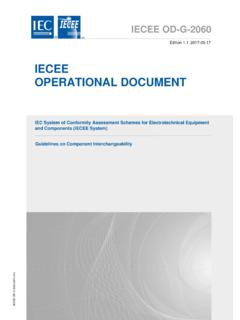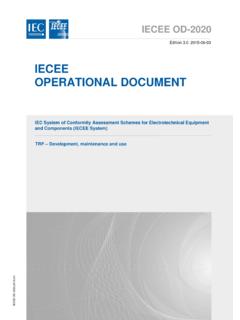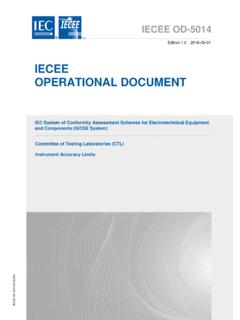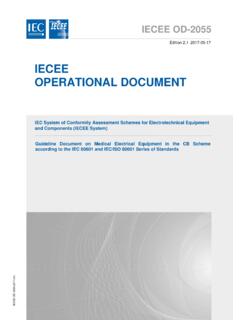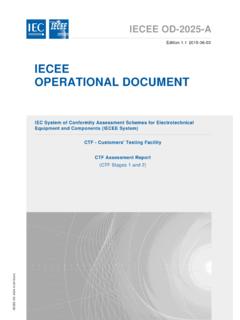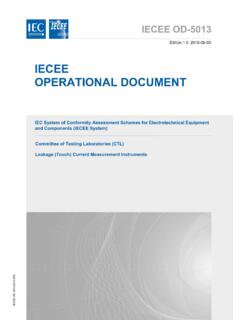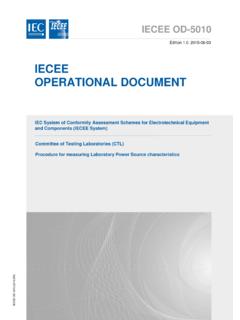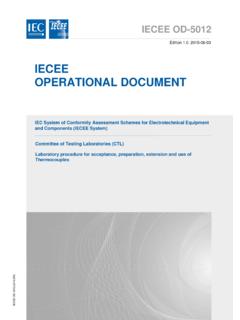Transcription of IECEE OPERATIONAL DOCUMENT
1 IECEE OD-2039 Edition 2017-05-17 IECEE OPERATIONAL DOCUMENT Acceptance of Components within the IECEE and Component Acceptance Matrix IECEE OD-2039:2017(en) IEC System of Conformity Assessment Schemes for Electrotechnical Equipment and Components ( IECEE System) Disclaimer: This DOCUMENT is controlled and has been released electronically. Only the version on the IECEE Website is the current DOCUMENT version THIS PUBLICATION IS COPYRIGHT PROTECTED Copyright 2017 IEC, Geneva, Switzerland All rights reserved. Unless otherwise specified, no part of this publication may be reproduced or utilized in any form or by any means, electronic or mechanical, including photocopying and microfilm, without permission in writing from either IEC or IEC's member National Committee in the country of the requester. If you have any questions about IEC copyright or have an enquiry about obtaining additional rights to this publication, please contact the address below or your local IEC member National Committee for further information.
2 IEC Central Office Tel.: +41 22 919 02 11 3, rue de Varemb Fax: +41 22 919 03 00 CH-1211 Geneva 20 Switzerland About the IEC The International Electrotechnical Commission (IEC) is the leading global organization that prepares and publishes International Standards for all electrical, electronic and related technologies. About IEC publications The technical content of IEC publications is kept under constant review by the IEC. Please make sure that you have the latest edition, a corrigenda or an amendment might have been published. Useful links: IEC publications search - The advanced search enables you to find IEC publications by a variety of criteria (reference number, text, technical committee,..). It also gives information on projects, replaced and withdrawn publications. IEC Just Published - Stay up to date on all new IEC publications.
3 Just Published details all new publications released. Available on-line and also once a month by email. Electropedia - The world's leading online dictionary of electronic and electrical terms containing more than 30 000 terms and definitions in English and French, with equivalent terms in additional languages. Also known as the International Electrotechnical Vocabulary (IEV) on-line. Customer Service Centre - If you wish to give us your feedback on this publication or need further assistance, please contact the Customer Service Centre: 2 IECEE OD-2039:2017 IEC 2017 Disclaimer: This DOCUMENT is controlled and has been released electronically. Only the version on the IECEE Website is the current DOCUMENT version CONTENTS CONTENTS .. 2 3 1 Scope .. 4 2 Definitions.
4 4 Component .. 4 Harmonized standard .. 4 National standard technically equivalent to IEC standard .. 4 Component Acceptance Matrix (CAM) .. 4 Certification documentation .. 5 3 General Principles .. 5 4 Potential situations for component requirements .. 5 5 Component acceptance situations .. 5 Existing IEC Component Standard .. 5 No existing IEC Component Standard .. 7 6 Component Acceptance Matrix .. 7 Responsibilities of the NCBs .. 8 Responsibilities of the IECEE Secretariat .. 8 CAM Database details .. 8 Additional Rules for completing the Component Acceptance Matrix .. 8 7 Component information in the CB Test Reports .. 9 Proof of component compliance .. 9 IECEE OD-2039:2017 IEC 2017 3 Disclaimer: This DOCUMENT is controlled and has been released electronically. Only the version on the IECEE Website is the current DOCUMENT version FOREWORD DOCUMENT Owner CMC WG 5 Acceptance of Components within the IECEE and Component Acceptance Matrix History of changes Date Brief summary of changes 2017-03-15 Adding of disclamer, adding of this foreword including History of changes, caluse 4,4 is modified and 4,5 is added to reflect the PAC decision (15/2014) Effective date Target revision date 2017-05-17 2020-05-17 4 IECEE OD-2039:2017 IEC 2017 Disclaimer: This DOCUMENT is controlled and has been released electronically.
5 Only the version on the IECEE Website is the current DOCUMENT version Introduction This OPERATIONAL DOCUMENT contains definitions and basic principles for acceptance of components within the IECEE . The intended implementation of this DOCUMENT is to enhance the common understanding among the National Certification Bodies (NCBs) participating in the Schemes of the various component acceptance scenarios encountered by the members, as well as, to establish a minimum proof of component compliance with the applicable acceptance criteria expected in the CB Test Reports. Any differences between the requirements in this OPERATIONAL DOCUMENT and corresponding requirements of the NCB shall be clearly identified and published in the CB Bulletin and in the Component Acceptance Matrix.
6 The Component Acceptance Matrix (CAM) is part of the component acceptance process. It was prepared to provide information on the level of harmonization with the IEC standards among the participating countries. The database should also assist the National Certification Bodies and CB Testing Laboratories in the compilation of the CB Test Reports by making the requirements for components more transparent. Today, IECEE has two procedures in dealing with acceptance of components in the end products. This OPERATIONAL DOCUMENT describes generic approach to component acceptance. Component acceptance declarations prepared by the NCBs are a tool for improving component acceptance under the generic approach. 1 Scope This DOCUMENT describes component related situations and decisions in the process of issuing and accepting CB Test Reports and Certificates for end products.
7 It also provides requirements and clarifications for the use of Component Acceptance Matrix. 2 Definitions Component For the purpose of this DOCUMENT a component has been defined as follows: Component a part or a subassembly intended to be installed into an end product in a factory by the end-product manufacturer. Some examples are: switches for appliances, capacitors, filters, fuseholders, build-in power supply, internal CD Rom or hard drive, and similar. Harmonized standard For the purpose of this DOCUMENT a harmonized standard issued by a national ( DIN, ANSI, SCC, BSI) or regional ( CENELEC) body has been defined as follows: Harmonized standard means a standard that is nationally recognized as a standard harmonized with IEC and for which there are published and readily available National or Regional Differences from the IEC requirements.
8 National standard technically equivalent to IEC standard For the purpose of this DOCUMENT , the term technically equivalent standard means that even though the national standard is not officially declared as harmonized with the IEC requirements, all parameters have either the same or more stringent requirements as declared by the NCB (in cooperation with the Member Body, as applicable). Note: Any national differences that need to be addresses for full compatibility of both standards are clearly identified by the NCB claiming technical equivalency of the national standard. Component Acceptance Matrix (CAM) CAM is a database containing compilation of IECEE component acceptance practices by the NCBs participating in the IECEE . IECEE OD-2039:2017 IEC 2017 5 Disclaimer: This DOCUMENT is controlled and has been released electronically.
9 Only the version on the IECEE Website is the current DOCUMENT version Certification documentation For the purpose of this DOCUMENT , a certificate, a license, or similar evidence of certification are considered equivalent. See clause 3 General Principles Components shall comply with the relevant requirements of the applicable component standards and the component requirements of the end-product standard. NCBs in countries that have not yet harmonized their component standards with IEC standards are strongly recommended to develop procedures permitting the acceptance of tests based on IEC component standards or on national component standards of the accepting NCB. All component related differences in requirements and acceptance practices shall be declared by the NCBs (in cooperation with the Member Body) in the CB Bulletin and in the CAM.
10 4 Potential situations for component requirements The following four cases can be identified: There is an existing IEC standard for the component; There is no IEC standard but there is a regional or national standard for the component; No component requirements exist; The end-product standard contains additional component requirements. The end-product standard contains all applicable component requirements. 5 Component acceptance situations The existence of an IEC standard for a component is the most desired situation, however, IEC standards do not exist for all components. The following outlines procedures for the acceptance of components for the situations identified above. Existing IEC Component Standard Two potential situations were identified as outlined in and below: Component with CB Test Certificate Where a component is provided with its own valid CB Test Certificate accompanied by the Test Report or information describing the conditions of component acceptability the following acceptance situations shall be considered.

